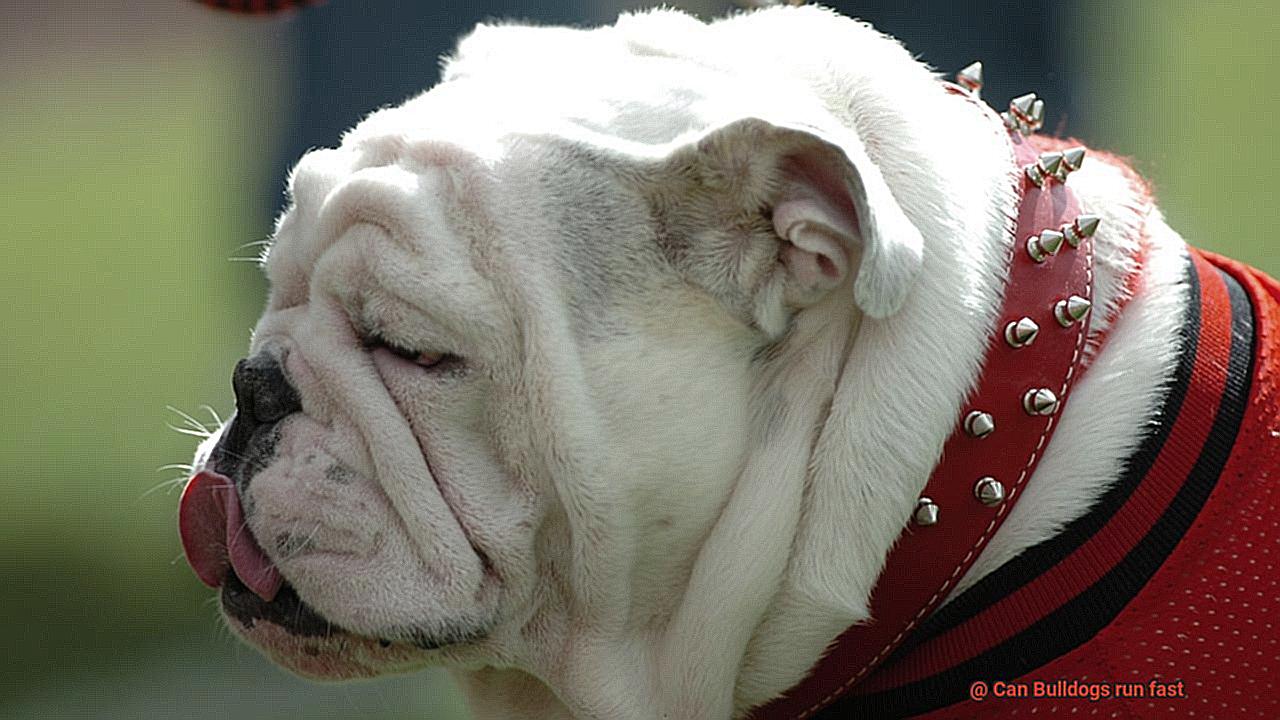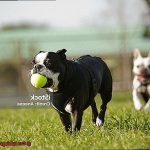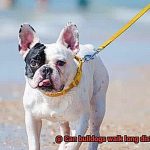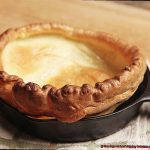Can Bulldogs run fast?
Do Bulldogs have a need for speed? You might think of Bulldogs as lazy couch potatoes, but don’t be fooled. These stocky pups are more agile than they appear and can actually run pretty darn fast. Prepare to be amazed.
While Bulldogs may not win any marathons, they do have bursts of energy that allow them to sprint short distances with surprising speed. Imagine a Bulldog zooming across the yard, tongue hanging out and ears flapping in the wind. Their powerful legs propel them forward like lightning. It’s a sight that’ll leave you in awe.
Now, let’s be clear – Bulldogs aren’t built for long-distance running. Their muscular bodies and hefty frames make them better suited for quick dashes rather than endurance races. But that doesn’t mean they’re lacking in athletic prowess.
Sure, Bulldogs may not compete in professional races like Greyhounds or Whippets, but they have their own special talents. With their adorable wrinkled faces and unique swagger, these dogs win hearts wherever they go. Plus, their gentle and affectionate nature adds an extra dose of charm.
So, while Bulldogs may not break any land-speed records, they bring plenty of joy and entertainment with their speedy antics. Next time you see one waddling down the street, remember that beneath that relaxed exterior lies a furry speed demon ready to show off their impressive moves. Get ready to be charmed by these four-legged speedsters.
The Physical Limitations of Bulldogs
Contents
- 1 The Physical Limitations of Bulldogs
- 2 How to Exercise Your Bulldog Safely
- 3 Can Bulldogs Run Fast?
- 4 Understanding the Unique Body Structure of Bulldogs
- 5 Respiratory Issues That Impact Speed and Endurance in Bulldogs
- 6 Low-Impact Activities for Bulldogs
- 7 The Benefits of Owning a Bulldog
- 8 Tips for Taking Care of Your Bulldog
- 9 Conclusion
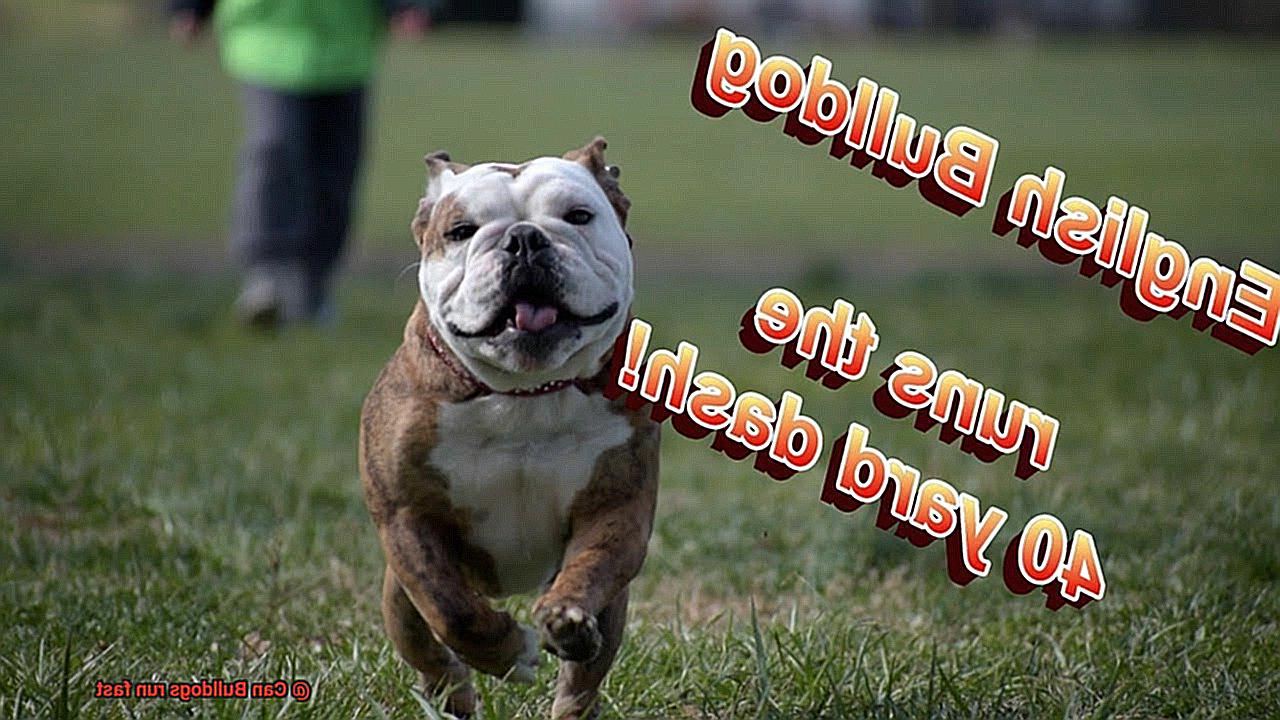
Bulldogs have a unique body structure that impacts their ability to run fast and engage in certain physical activities. In this comprehensive guide, we will explore the specific physical limitations of Bulldogs and why it is crucial for owners to tailor their exercise routines accordingly.
Brachycephalic Breeds and Respiratory Challenges:
Bulldogs belong to the brachycephalic breed category, characterized by their short and flat skulls. This feature affects their respiratory system, making it harder for them to breathe compared to other breeds. Their short noses and narrow airways can lead to overheating and even heatstroke, especially during exercise or hot weather.
Stocky Build and Limited Running Ability:
Bulldogs have a stocky and muscular body structure that prioritizes strength and stability over speed and agility. Their heavy bones, short legs, and wide chest make it challenging for them to run fast or cover ground quickly. Despite their limited running ability, Bulldogs can still enjoy moderate exercise such as short walks or play sessions.
Weight and Orthopedic Issues:
Bulldogs tend to be on the heavier side, which puts additional strain on their joints. This excess weight can lead to orthopedic issues such as hip dysplasia or arthritis, further impeding their running ability. It is crucial for owners to monitor their Bulldog’s weight and provide a balanced diet to maintain a healthy body condition.
Endurance Limitations:
Due to their physical limitations, Bulldogs are not built for endurance activities. Engaging in prolonged exercise or high-intensity activities can quickly exhaust them and potentially lead to health issues. It is important for owners to recognize the signs of fatigue in their Bulldogs and provide ample rest and water breaks during any physical activity.
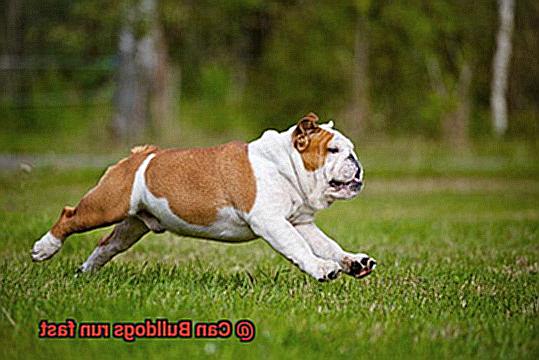
How to Exercise Your Bulldog Safely
French Bulldogs, with their adorable squishy faces and lovable personalities, make fantastic companions. However, their unique body structure and respiratory issues require special considerations when it comes to exercise. In this blog post, we will explore how to exercise your Bulldog safely and effectively to keep them both physically and mentally fit.
The Importance of Consultation:
Before starting any exercise routine with your Bulldog, it’s crucial to consult with your veterinarian. They can assess your dog’s overall health and provide specific recommendations based on their individual needs. Your vet can also help you identify any potential health issues that may affect their exercise capabilities.
Choose the Right Time and Place:
Bulldogs are prone to overheating due to their short snouts, so it’s important to exercise them during cooler times of the day, such as early morning or late evening. Avoid exercising them in extreme temperatures or direct sunlight. Additionally, select safe and comfortable environments for exercise, such as parks or open spaces away from busy roads.
Gradual Intensity and Duration:
Start slow and gradually increase the intensity and duration of exercise. Bulldogs are not known for their endurance, so pushing them too hard can lead to exhaustion or heatstroke. Shorter bursts of activity, such as multiple short walks throughout the day, can be more beneficial than one long walk.
Low-Impact Activities:
Swimming is an excellent low-impact exercise option for Bulldogs. It helps to cool them down while providing a full-body workout. Always supervise your Bulldog while swimming and ensure they have a safe entry and exit point from the water. Avoid high-impact activities like jumping or intense running that can strain their joints.
Mental Stimulation:
Bulldogs are intelligent dogs and need mental stimulation to stay happy and healthy. Incorporate puzzle toys or training sessions into their exercise routine to keep their minds engaged. This not only provides mental stimulation but also helps tire them out when physical exercise may not be sufficient.
Can Bulldogs Run Fast?
French Bulldogs are undeniably adorable with their squishy faces and stocky builds. But can these lovable companions run fast? In this article, we’ll explore the factors that influence Bulldogs’ running ability, debunking the myth surrounding their speed.
Understanding Bulldogs’ Physical Structure:
Bulldogs are not typically known for their speed, and there’s a reason behind it. Their physical structure plays a significant role in their running capabilities. With a low-slung and compact body, short legs, and a heavy head, Bulldogs face inherent challenges when it comes to high-speed running.
Factors Influencing Bulldogs’ Running Ability:
- Muscular Build: Bulldogs have a muscular build, which gives them strength but not necessarily speed. Their bodies are designed for power rather than agility.
- Breed History: Bulldogs originated as working dogs for bull-baiting, where their strength and tenacity were valued over speed. Over time, these dogs have undergone anatomical changes to fit their new role as companion animals.
- Health Concerns: Bulldogs are prone to respiratory problems and joint conditions. Excessive exercise or overexertion can exacerbate these issues, making it crucial to monitor their activity levels and provide appropriate exercise for their individual needs.
Enjoying Exercise within Limitations:
While Bulldogs may not be the fastest runners, they still enjoy physical activity and exercise. Regular walks and moderate exercise are essential for maintaining their overall health and well-being.
However, it’s important to remember that Bulldogs have limitations due to their physical structure and health concerns. Here are some tips for creating an enjoyable exercise routine for your Bulldog:
- Short Bursts of Energy: Bulldogs may surprise you with bursts of energy and enthusiasm during playtime. While they may not sustain high speeds for extended periods, they can still have fun running around in short bursts.
- Low-Impact Activities: Instead of focusing on high-speed running, consider engaging Bulldogs in activities that are gentle on their joints, such as swimming or agility training. These activities cater to their specific abilities and limitations.
- Mental Stimulation: Bulldogs are intelligent dogs that benefit from mental stimulation. Incorporate puzzle toys and training sessions into their exercise routine to keep their minds sharp and engaged.
Understanding the Unique Body Structure of Bulldogs
Bulldogs are undeniably adorable with their wrinkled faces and stocky bodies, but their unique body structure does have an impact on their ability to run fast. As an expert on Bulldogs, I can shed some light on how their physical characteristics affect their running capabilities and what activities they can still enjoy.
Short and Stout Build:
One look at a Bulldog and you’ll notice their short and stout build. Their low-to-the-ground stature, wide chest, and broad shoulders give them a distinctive appearance. However, this body structure poses challenges when it comes to running fast.
Bulldogs have short and stocky legs, making it difficult for them to take long strides or maintain a high speed. Their hind legs are longer than their front legs, which gives them a waddling gait. While this may be adorable to watch, it hinders their ability to run with grace and agility.
Breathing Difficulties:
Another factor that affects Bulldogs’ running ability is their brachycephalic (short-nosed) face. This unique facial structure can cause breathing difficulties and overheating during physical activities, including running.
Bulldogs have narrowed nostrils, elongated soft palates, and a small windpipe, which make it harder for them to breathe efficiently when exerting themselves. The wrinkles and folds on their face can also trap moisture, further exacerbating the issue and making it challenging for them to cool down effectively.
Weight Management:
Bulldogs have a tendency to carry excess weight, which can further hinder their agility and speed. It’s crucial for Bulldog owners to monitor their pet’s weight closely and provide them with a balanced diet to prevent obesity.
Regular exercise is essential for Bulldogs to maintain a healthy weight and overall well-being. However, it’s important to keep in mind that Bulldogs may not excel in activities that require high speed or endurance due to their unique body structure.
Activities for Bulldogs:
While Bulldogs may not be the fastest runners, they can still enjoy physical activities that suit their limitations. Low-impact exercises such as walking and swimming are great options to keep them active and burn off energy.
Short bursts of playtime, like a game of fetch or tug-of-war, can also provide mental stimulation and exercise. It’s important to pay attention to their breathing and not push them beyond their comfort level. Always provide plenty of water and shade during outdoor activities to help them stay cool.
Respiratory Issues That Impact Speed and Endurance in Bulldogs
Bulldogs are known for their adorable wrinkled faces and stocky build, but these features can often lead to respiratory issues that affect their speed and endurance. In this blog post, we will explore the common respiratory problems that Bulldogs face and how they can impact their ability to run fast. We will also share tips and insights on managing these issues to help your French Bulldog thrive.
Stenotic Nares:
- Bulldogs have narrowed nostrils, known as stenotic nares, which restrict the airflow.
- This makes it harder for them to breathe properly, especially during intense physical activities.
- Symptoms may include snorting, wheezing, and excessive panting.
- Surgical intervention, such as nares resection, can widen the nostrils and improve airflow.
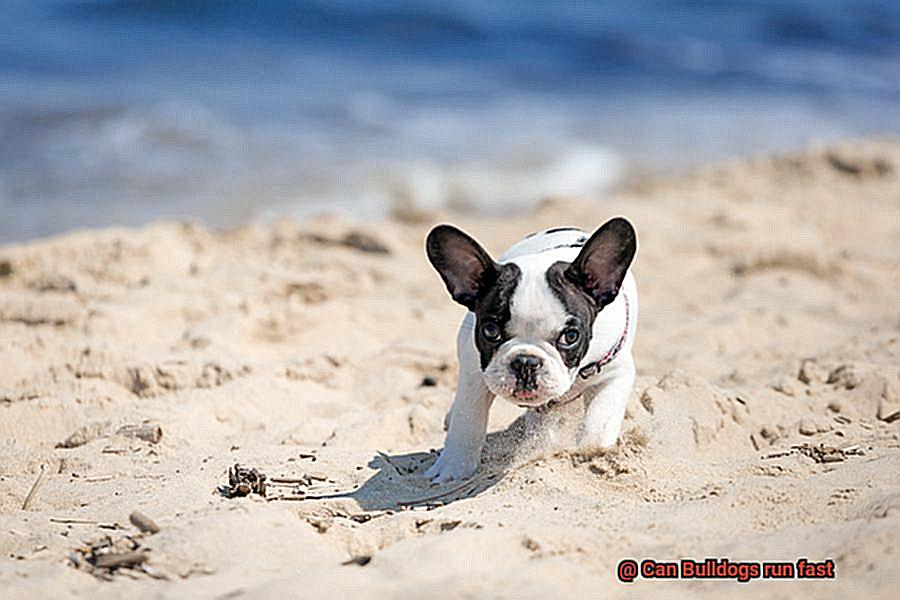
Elongated Soft Palate:
- Bulldogs often have an elongated soft palate, which obstructs the airway.
- This causes difficulty in breathing during exercise and can lead to fatigue.
- Surgical trimming of the soft palate can reduce obstruction and improve respiratory function.
Narrowed Trachea:
- Bulldogs may also have a narrower trachea, further compromising their ability to breathe freely.
- The reduced tracheal diameter limits oxygen intake and affects overall performance.
- Consult with a veterinarian to assess your bulldog’s respiratory health and discuss treatment options.
Managing Respiratory Issues:
- Moderate exercise is crucial, avoiding overexertion and extreme weather conditions.
- Maintaining a healthy weight is essential to reduce strain on the airways.
- A balanced diet and portion control can prevent obesity and alleviate respiratory symptoms.
- Provide a cool and well-ventilated environment for your bulldog to ensure their comfort.
Low-Impact Activities for Bulldogs
Walking:
Take your Bulldog for regular walks to keep them active and healthy. Walking is a low-impact activity that helps burn calories, improve cardiovascular health, and strengthen their muscles. Plus, it’s a great way to bond with your furry friend.
Swimming:
If your Bulldog loves water, swimming is an excellent low-impact activity for them. It provides a full-body workout without putting pressure on their joints. Swimming is especially beneficial for Bulldogs with joint issues or arthritis.
Interactive play sessions:
Engage your Bulldog in interactive play sessions to provide mental stimulation and physical exercise. Play fetch with a soft toy or engage in a game of tug-of-war with a rope. These low-impact activities will keep them entertained while keeping their muscles active.
Puzzle toys:
Challenge your Bulldog’s mind and body with puzzle toys or treat-dispensing toys. These toys require them to work to retrieve treats or solve puzzles, providing mental stimulation and some physical activity.
Indoor games:
When the weather is not suitable for outdoor activities, indoor games like hide-and-seek or obstacle courses can be a fun way to keep your Bulldog active. These low-impact activities will keep them entertained while burning off some energy.
Remember, it is essential to start any new activity gradually and monitor your Bulldog’s response. If they show signs of fatigue or discomfort, modify the activity or stop it altogether to prevent injury.
Consulting with a veterinarian before starting any new exercise routine is recommended, as they can provide guidance based on your Bulldog’s individual needs and health condition.
The Benefits of Owning a Bulldog
If you’re considering adding a furry friend to your family, look no further than the lovable Bulldog. With their unique appearance and friendly nature, Bulldogs make excellent companions for individuals and families alike. In this article, we’ll explore the benefits of owning a Bulldog and why they are a great choice for those looking for a low-maintenance and loving pet.

Friendly and Affectionate
Bulldogs are known for their friendly and affectionate nature. They love to be around their human companions and are often referred to as “gentle giants.” Whether you’re spending time on the couch or going for a leisurely walk, Bulldogs will be by your side, providing companionship and love.
Low Exercise Requirements
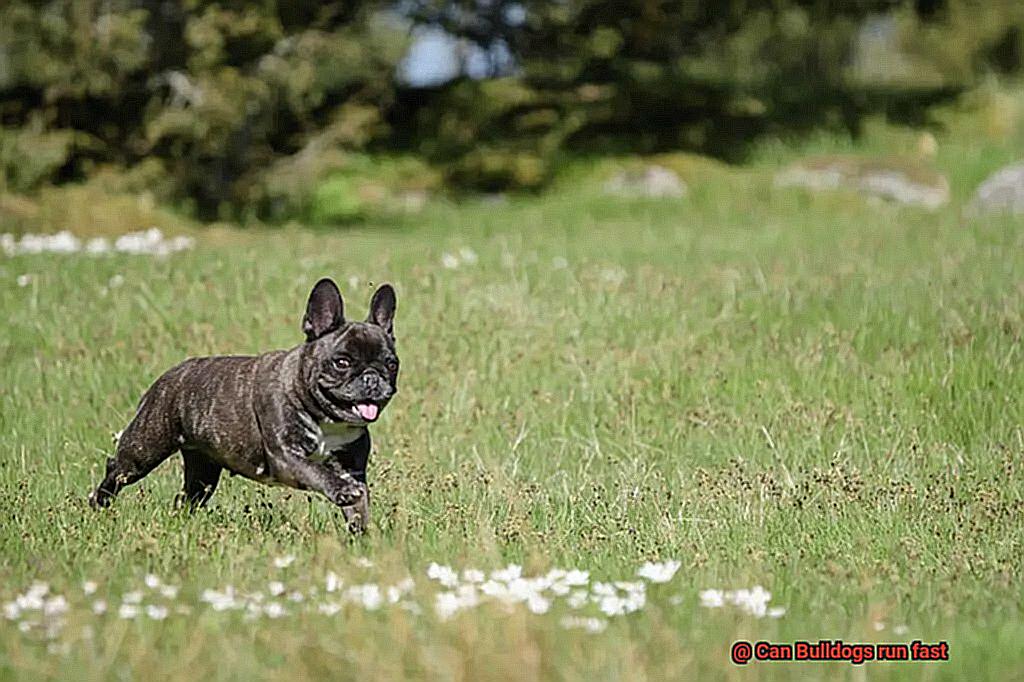
Unlike some high-energy dog breeds, Bulldogs have low exercise requirements. They are not built for intense physical activity and can easily overheat due to their short snouts. This makes Bulldogs ideal for individuals or families who prefer a more relaxed lifestyle. Short walks and indoor playtime are enough to keep them happy and healthy.
Adaptability
One of the great things about Bulldogs is their adaptability to different living situations. Whether you live in an apartment or have a house with a yard, Bulldogs can adjust well to various environments. They are not overly demanding in terms of space, making them suitable for both urban and suburban living.
Good with Children
If you have children, Bulldogs make excellent family pets. They are patient and tolerant, making them ideal playmates for kids. Bulldogs have a gentle nature and are known for their ability to get along well with children of all ages.
Minimal Grooming
When it comes to grooming, Bulldogs require minimal maintenance compared to other breeds. Their short coat is relatively easy to care for, requiring only occasional brushing and bathing. This makes them a great choice for individuals who don’t have a lot of time for grooming or prefer a low-maintenance pet.
Tips for Taking Care of Your Bulldog
If you have a Bulldog, you know they are special dogs with unique physical characteristics. Bulldogs may not be the fastest runners, but they make up for it with their friendly and affectionate nature. To ensure your Bulldog stays healthy and happy, here are some tips for taking care of them.
Balanced Diet:
Bulldogs have a tendency to gain weight easily, so it’s important to feed them a balanced and nutritious diet. Consult with your veterinarian to determine the right type and amount of food for your Bulldog. Avoid giving them excessive treats or table scraps as this can lead to weight gain and other health issues.
Regular Exercise:
While Bulldogs may not be built for speed, they still need regular exercise to maintain a healthy weight and prevent boredom. Short walks or play sessions in a fenced area can help keep them active and engaged. However, it’s important to avoid overexertion, especially in hot weather, as Bulldogs are susceptible to heatstroke.
Grooming Routine:
Bulldogs have a short coat, but they still require regular grooming to keep their skin and coat healthy. Brush them at least once a week to remove loose hair and prevent matting. Additionally, clean their facial folds daily with a damp cloth to prevent bacterial infections and odor buildup.
Dental Care:
Bulldogs are prone to dental issues, so establishing a dental care routine is essential. Brush their teeth regularly using a dog-specific toothbrush and toothpaste. Additionally, provide them with dental chews or toys that can help reduce plaque buildup and maintain good oral hygiene.
Regular Veterinary Check-ups:
Bulldogs are prone to various health conditions such as hip dysplasia, allergies, and respiratory problems. Regular visits to the veterinarian can help detect any potential issues early on and ensure that your Bulldog receives the necessary vaccinations and preventive care.
Comfortable Living Environment:
Bulldogs are sensitive to extreme temperatures, so it’s important to provide them with a comfortable living environment. Ensure that they have access to shade and fresh water during hot weather, and provide them with a warm and cozy bed during colder months.
q2b9Fn16JFs” >
Conclusion
In conclusion, it is clear that Bulldogs are not known for their speed. These lovable and sturdy dogs have a stocky build and a unique anatomy that hinders their ability to run fast. Their short legs, broad chests, and heavy bodies make them more suited for activities like lounging on the couch or taking leisurely strolls in the park.
While Bulldogs may not be the fastest runners, they make up for it with their charming personalities and affectionate nature. Their loyal and gentle demeanor endears them to many dog lovers around the world. So even if they can’t sprint like a greyhound or dash like a cheetah, Bulldogs still bring joy and companionship to their owners.
It’s important to remember that every dog is unique and has its own strengths and abilities. While Bulldogs may not excel in speed, they excel in other areas such as being great family pets or therapy dogs. So don’t let their lack of speed deter you from considering a Bulldog as your furry companion.
In conclusion, Bulldogs may not be the fastest runners in the canine world, but they have plenty of other qualities that make them wonderful pets. Their charm, loyalty, and affectionate nature more than compensate for their lack of speed.
